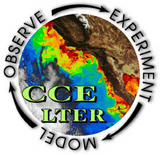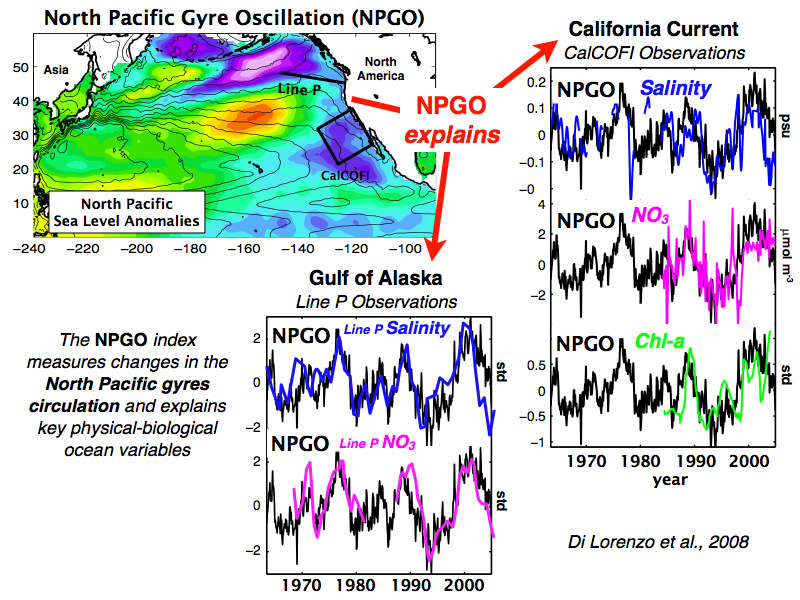Di Lorenzo
E., Schneider
N.,
Cobb
K. M., Chhak, K, Franks P. J. S.,
Miller
A. J., McWilliams J. C., Bograd S. J., Arango H., Curchister E., Powell
T. M. and P. Rivere, 2008: North Pacific Gyre Oscillation links ocean
climate and ecosystem change. Geophys. Res. Lett., 35, L08607,
doi:10.1029/2007GL032838.
 [
PDF ]
[
PDF ]
Get the NPGO index - [ Download Index | Plot Index ] - NEW routine updates monthly
The North Pacific Gyre
Oscillation (NPGO) is a climate pattern that emerges as the
2nd dominant mode of sea surface height variability (2nd EOF SSH)
in the Northeast Pacific. The NPGO is significantly correlated with
previously unexplained fluctuations of salinity, nutrients
and chlorophyll-a measured in long-term observations in the
California Current (CalCOFI) and Gulf of Alaska (Line P). We use the term NPGO because its fluctuations
reflect changes in the intensity of the central and eastern branches of the
North Pacific gyre circulations as evident from the NPGO SSHa anomalies.
Fluctuations in the NPGO are driven by regional and basin-scale variations
in wind-driven upwelling and horizontal advection- the fundamental processes
controlling salinity [figure]
and nutrient
[figure]
concentrations. Nutrient fluctuations drive concomitant changes in
phytoplankton concentrations, and may force similar variability in higher
trophic levels. The NPGO thus provides a strong indicator of fluctuations in
the mechanisms driving planktonic ecosystem dynamics.
We use the term NPGO because its fluctuations
reflect changes in the intensity of the central and eastern branches of the
North Pacific gyre circulations as evident from the NPGO SSHa anomalies.
Fluctuations in the NPGO are driven by regional and basin-scale variations
in wind-driven upwelling and horizontal advection- the fundamental processes
controlling salinity [figure]
and nutrient
[figure]
concentrations. Nutrient fluctuations drive concomitant changes in
phytoplankton concentrations, and may force similar variability in higher
trophic levels. The NPGO thus provides a strong indicator of fluctuations in
the mechanisms driving planktonic ecosystem dynamics.
ENSO and NPGO: an integrated framework for Pacific decadal dynamics - [ENSO/NPGO webpage]
The decadal dynamics of the Pacific Decadal Oscillation (PDO) and the North Pacific Gyre Oscillation (NPGO) are linked through their relationships to ENSO. This results provides the basis for a framework for quasi-deterministic decadal oscillations of Pacific climate. [see ENSO/NPGO Webpage]
Relation between NPGO, PDO and Victoria Mode
The NPGO mode closely tracks the second EOF of North Pacific SSTa, also referred to as the "Victoria Mode" [figure] (Bond et al., 2003). The NPGO is distinct from the Pacific Decadal Oscillation (PDO) mode (Mantua et al., 1997), which emerges as the first mode of SSTa and SSHa in the Northeast Pacific. However the NPGO is the dominant mode for salinity and nutrients [figure].
Decadal modulation of coastal upwelling - PDO vs. NPGO
Along the coast the atmoshperic forcing associated with both the PDO and NPGO control decadal modulation of the upwelling cells, resulting in non-spatially-uniform responses of coastal upwelling. The PDO signal is strong north of 38N and the NPGO is strong south of 38N along the California Current System [figure].
Large-scale structure of the NPGO in the Pacific
The NPGO pattern extends beyond the North Pacific and is part of a global-scale mode of climate variability that is evident in global sea level trends and sea surface temperature [figure]. The symmetric structure and ENSO-like shape of the SSTa associated with the NPGO suggests that coupled tropical dynamics are involved in the dynamics of the NPGO.
NPGO linked to decadal variations in the Kuroshio-Oyashio Extension (KOE)
The NPGO is locally forced by surface wind variability associated with the North Pacific Oscillation (NPO), which is a fluctuation in sea level pressure characterized by high pressure over Hawaii and low pressure in the Gulf of Alaska (Walker and Bliss, 1932). Therefore the NPGO is the oceanic expression of the NPO. The oceanic sea level anomalies forced by the NPO trigger an oceanic adjustment with radiation of westward propagating Rossby wave signals that reach the North Pacific western boundary and modulate decadal variations in the KOE [figure]. The role of Rossby waves in modulating decadal variations in the KOE has been noted before (Qiu et al., 2005; Miller et al., 2000; Taghuci et al. 2007), therefore the NPGO provides an important link between prominent decadal variations in the eastern and western boundaries.
Ecosystem variations in the Pacific and NPGO
The NPGO has been shown to control nutrient and Chl-a variations in the Northeast Pacific. However the NPGO exhibit a large-scale structure in SSH and SST, which is also evident in satellite Chl-a from SeaWiFS [figure]. This suggest that NPGO type variability may be invoked to explain ecosystem variations throughout the Pacific.
____________________________________
This work is sponsored by the
National Science Foundation,
US GLOBEC Program and NASA MAP Program
through the Physical and Biological Oceanography programs

